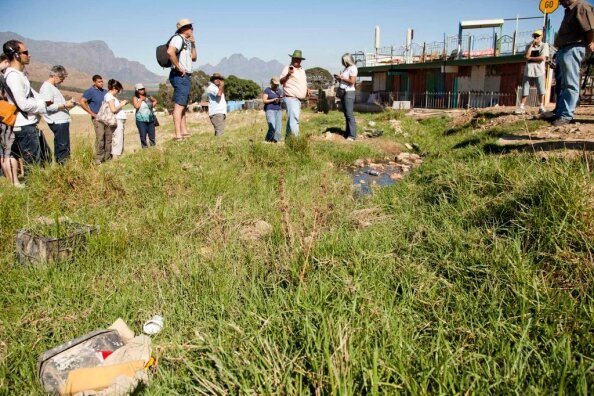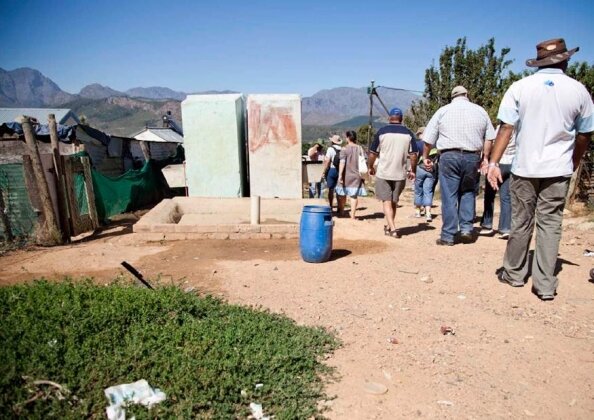Genius of Place
A Genius of Place review brings an understanding of the pre-tested, locally attuned sustainability strategies adopted by the local organisms and ecosystems specific to a design challenge. biomimicrySA aims to complete a number of Genius of Place reviews for key South African regions. We are seeking funding for these projects. The first initiative we aim to complete is the Genius of Place review for the Western Cape. See more information below and contact us if you are interested in participating in or funding this initiative in part or in full.
Western Cape Genius of Place Review

This initiative developed from, and forms part of theWestern Cape 110% Green Initiative. The Biomimicry Genius of Place is a registered flagship project of 110% Green. This initiative combines two priorities of the Western Cape Government – the Berg River and the Green Economy – to find an innovative solution to water pollution in the Berg River.
PHASE 1: FEASIBILITY STUDY

Water has been identified as one of the major risks facing the Western Cape and is also being prioritised in the Green Economy Strategic Framework. An innovative project was conceptualised in 2012 in conjunction with biomimicrySA and the 110% Green Project to address the issue of water pollution in the Western Cape.
The concept ‘Genius of Place’ looks at the unique environment of the Western Cape in order to find context specific solutions to the water problem. The project is being undertaken in collaboration with the Berg River Improvement Plan Task Team. The aim of the collaboration is to find a solution to a specific water problem in the Berg River. This forms part of Phase 1: The Feasibility Study of the project which included a visit to the Berg River and its surrounds.
Between February and early April 2013 biomimicrySA successfully completed a scoping phase for the Genius of Place Project and delivered a feasibility report. The areas that were explored were aligned to the Berg River Improvement Plan and included:
- Water Quality Monitoring
- Waste Water Treatment
- Upgrading Informal Settlements
- Agricultural Best Practices
- Riparian Zone Rehabilitation and
- Proper Pricing of Water
The feasibility report focused specifically on the following questions:
- "Can biomimicry impact positively on the challenges experienced in the Berg River area?”
- “In which way can biomimicry have an impact?”
During the course of this phase, biomimicrySA used the biomimicry tools and methodology to explore both global and locally appropriate technology solutions to the challenges relating to the 6 areas above. In addition, the research included identifying locally attuned organisms and systems of the area (the Genius of Place). The team also identified potential opportunities for job creation informed by Blue Economy thinking.
The outcomes of the feasibility report were presented by biomimicrySA to the key stakeholders in April 2013. The presentation highlighted examples of Biomimicry Technology, Biomimicry Methodology, and Biomimicry Thinking that offer possible solutions to each of the 6 areas listed above.
Three primary issues were identified as having the biggest impact on the health of the Berg River system:
- Informal settlements and the difficulties in dealing with grey and black wastewater that bypass the formal system.
- The current wastewater treatment plants and how they operate
- The loss of indigenous vegetation along the river which would act as a buffer to naturally filter certain excess pollutants.
Phase 2 of the project began in May 2013 with the aim of developing a strategic plan for implementation of a biomimicry solution for one of the key challenges identified.
PHASE 2: DEVELOPING A STRATEGIC PLAN FOR IMPLEMENTATION

Phase 2 involved research into practical strategies inspired by nature to deal with water related issues in the Berg River area in Franschhoek. Based on stakeholder engagement after the feasibility report, the focus area for phase 2 was selected. It was deemed the best approach was to focus on assessing and addressing issues surrounding wastewater, storm water and solid waste treatment in informal settlements along the Berg River. These settlements are estimated to account for a high proportion of toxins and waste entering the Berg River.
The second phase was a deep research phase that seeked to understand the context, both from a social and environmental perspective, helping to locate the project within an appropriate informal settlement. This settlement chosen needed to be receptive and fertile to ensure the project can be held and nurtured by those that will be the eventual owners of the outcomes. Langrug informal settlement was selected as the focus for this more detailed biomimicry study.
A portion of this work involved a kind of literature review. However this was not a literature review in the traditional academic sense. The focus was about discovering who all the actors are working within the Berg River area, that might benefit from or contribute towards a deeper level of collaboration across sectors and disciplines. This was to enable finding value solutions through creating win-win interactions around biomimicry opportunities in the informal settlement.
During this phase the team explored the key issues of water, wastewater, stormwater and solid waste management through site visits and engagement with the community through CORC. In addition, detailed research was undertaken around the Genius of Place – i.e. nature’s strategies and principles for managing water, wastewater, stormwater and waste in the local ecosystem. The research identified 25 different strategies from nature from which 3 key strategies were explored deeper to abstract design principles from nature. The team then designed conceptual solutions for the challenges in Langrug – with a focus on solutions at source – i.e. bioremediaton drainage channels for stormwater and greywater, and the use of ecomachines (biomimicry wastewater treatment systems) for treating sewerage at source.
These designs are to be explored in more detail going forward in the next phase of this project.
PHASE 3: DESIGNING, COSTING & IMPLEMENTING PROTOTYPE SOLUTIONS
Phase 3 of this project began in Feb 2014 and continues until March 2015. This phase involves engaging with the community in Langrug to locate and design 4 prototype biomimicry solutions to the key challenges identified in phase 2. These are to address the challenges of treating the wastewater and managing stormwater in the drainage channels in the informal settlement, as well as managing the solid waste to prevent it from ending up in the wastewater.
BiomimicrySA is working together with John Todd Ecological Designs to design an innovative solution to the wastewater challenge. John Todd Ecological Design, has constructed dozens of Eco-Machine wastewater treatment systems based on Dr. John Todd’s visionary ecological philosophy and award-winning practical designs in eleven countries on five continents around the world.
The team working on this challenge also includes In/formal South, Maluti Water, WaterLove Projects and CORC.
Why a Genius of Place Review?
Organisms and ecosystems face the same challenges that we humans do, but they meet those challenges sustainably. The premise of biomimicry is that Life has been performing design experiments in Earth’s R&D lab for 3.8 billion years and what is flourishing on the planet today are the best ideas – those that perform well in context, while economizing on energy and materials. Whatever the design challenge, the odds are high that one or more of the world’s 30 million creatures has not only faced the same challenge, but has evolved effective strategies to solve it.
The selective pressure placed on all natural life forms minimizes and removes failures. Organisms are the consummate physicists, chemists, and engineers, and ecosystems are economies beyond compare. They can provide us with innovative and progressive solutions to the design, engineering and other challenges that we now face: water, energy, food production, climate control, benign chemistry, transportation, packaging, and more. The vision is to create products, processes, buildings, organizations, systems and policies—new ways of living—that are well-adapted to life on earth over the long haul. ”Doing it nature’s way” has the potential to change the way we manage water, grow food, make materials, harness energy, heal ourselves, store information, and conduct business.
